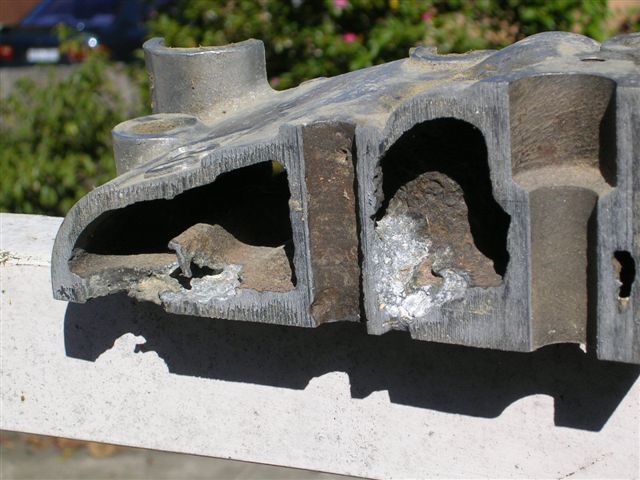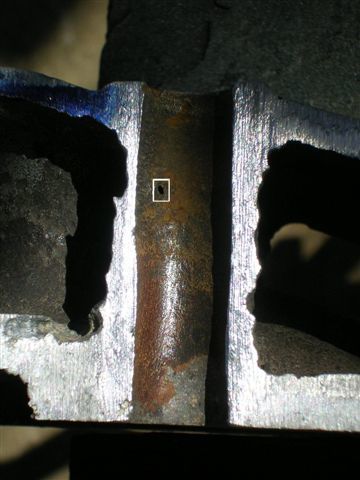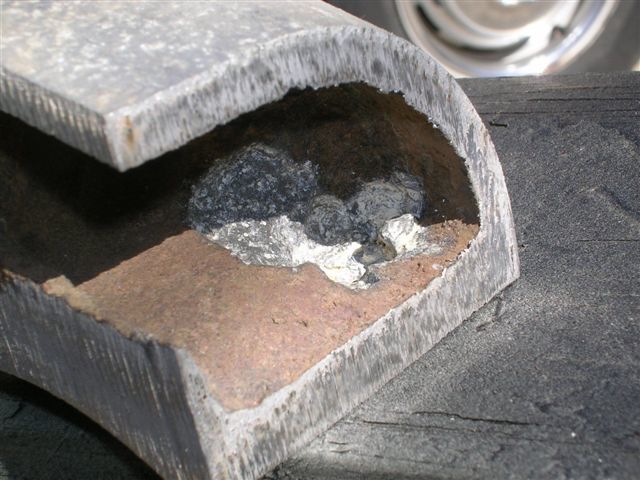Hi
I am currently rebuilding the engine of my XK 120 ots and have found considerable corrosion in the waterways. I am in Central Florida and am seeking a welder/ engineer who is capable of repairing waterways and replacing valves and guides. I am willing to drive for competence. Thanks in advance for any help.
Cheers
Tony
call Coventry West…to learn about sendin your head for an entire evaluation and rebuild. You will be very pleased (and if you could see into the future, perhaps not so pleased with piecmeal DIY repairs here and there)…Nick
Thanks for the replies and the head is now with Coventry West. Still need somebody local to work on the block. Any suggestions for central Florida machine shops?
Cheers
Tony
Could use a bit more information on this.
Be aware that welding a head will affect the hardness, and it should be re- heat treated , And that while you can weld the corrosion you can see, some can be where there is no access.
One would need to know that the welder was using suitable spec rods. Not a given by any means as when I asked alocal welder , we checked and there was a minimum order of 100 sticks.from the supplier.
Attached is a pic of a sectioned SS alloy cylinder head showing what one might expect internally
One showing the hole right through the pillar that th e head stud goes through. Owners weren’t too careful in the past about corrosion inhibitor, Is there any reason to believe your head would be different.


In reply to a message from Dick, I am looking for an engineer to strip , clean, measure rebore if necessary skim and order necessary bearings bushes pistons and rings.
Cheers
Tony
As you suspected my head was worse on the in side. I shipped it to Coventry West and upon stripping and inspection they deemed it not rebuildable. There goes the " matching numbers" thing and more $'s
Cheers
Tony
Hi Tony:
For what it is worth I have a factory replacement cylinder head (no stamped number at the front, but with the number: R682 stamped at the rear). It was fitted to a 1959 Mk IX, not sure if this would work for you, but if you are interested contact me off site (905-648-0329 or cphillipsxk@outlook.com)
Regards,
Chris.
Personally , I think XK owners [ and E Type/ MK II etc] should prepare themselves for more of this in the future.
The SS1s that have a few years head start are now finding that serviceable alloy heads are like hen’s teeth. WE’ve made many in the last few years as owners have realised that in the long term it’s cheaper to bite the bullet and get it over with , There’s a UK company making new heads and blocks. The heads are wide angle and the blocks are alloy D Type/ LW E Type etc and repro SS 3 1/2 litre blocks.
Obviously tooling costs will preclude every variation of twin can heads but the various casting number s are just standard pattern makers numerals and letters and can be interchanged. { WE have separate 16 and 20 HP inserts that can be swapped in the patterns.
Unfortunately most owners of early alloy headed cars had grown up with cast iron engines and corrosion inhibitors didn’t enter their radar.
Having been down the path of a properly repaired XK alloy head; i.e., welding, heat treating, machining, etc, a new replacement has a lot of appeal. It is likely cheaper that a repair, and more certain of success.
Indeed I past ties , making new heads would involve an experienced old pattern makers maing patterns and cores in wood. very complicated , time consuming , expensive and only somethimes needing adjustment from tril and error .
Now they can scan the object in and out ad get an extremely accurate program on a cumputer , which with a bit of fiddling can be used to 3 D print patterns and cores.
In fact a local VSCC member here had a 1913 GP Delage block reproduced this way , The film of it is on YouTube.
And fr those here who value ’ matching numbers;’ I would think a clever computer person [ i.e . teenager] could scan your original engine number off the head and insert that scan into the program into, so the final casting would have your original number exactly scanned from the original.
And as some wag at the VSCC meeting said [ " If you then melt your original down and pour ithe metal into the mould, what you get isn’'t even a replica"
This isn’t what might happen in the future, it’s what is happening now.
The power of CAD/CAM processes is immense, but it is important to not lose sight of the metallurgy of the situation to use the proper material, and the experience of foundrymen in gates, sprues and vents to get a good homogenous casting, A lot of people seem to think that aluminum is aluminum, and that the manufacturing process is of no importance - just look at the cast clutch throw arms which were forgings as an example of things gone wrong from ignorance of materials and manufacturing…
Ha, ha, ha!
And all of you, please please please use anti-freeze in a 50/50 solution with clean water even if you never see freezing temperatures, and flush it out every few years.
Karl Sorry just being silly about melting down old heads . Despite some thinkng that XK 120 heads were melted down Spitfires, Messerschmidts and saucepans.
We have our heads cast at a foundry where their day job is casting cylinder heads and blocks for manufacturers.
Repro blocks/ heads are already here . Pre war OHC MG blocks 4 and 6 cylinder are already cast in Aluminium , When painted, the scrutineers will never know. Likewise locally here they have started casting XPEG blocks and I know Lagonda Rapier blocks are done and Sunbeam twin cam … usually all these involve a bit of discrete improvements internally
The Lagonda Rapiers going from 1200cc to 1500.
5 litre XK 's ?
In any case the weight savings should help acceleration and handling .
Ed,
It is clear from the various projects you have been involved in over the years that you clearly know better.
My warning was prompted by a CNC guy in a Jay Leno “Magic of Computers” Video who seemed to believe that if you were to 3-D scan a part, you could send out a 3-D plastic “plot” of the part and they would cast you up a copy.to use on a car . No mention of material/alloy , and as I recall he did not even take into account shrinkage allowance.
Just curious; when they cast a custom block or head for you, how many shots does it typically take to get the gates, vents, and sprues right ?
Karl
Karl
I think some of the Jay Leno video is ’ made for tv’ I recall a barn find carthey startedand drove away BUtlater admitted that a day was spent preparing it.
The heads and stuff we’ve done have been made from patterns theold fashioned way A pattern maker carving wood sculptures. The various cores andpatterns even for the sidevalve SS1 head are quite coplex. BUtthese were done quite afew years ago.
The foundry make s the decisions on sprues and vents, well some of them.
Now we have done a few , they can go straight into it . I think they may have had a try intitially
In the case of the Delage cylinder block they did one casting and cut it into quarters to see how everything looked inside… water galleries etc. The parts of the water gallery they couldn’t scan wit endoscopes etc they were able to calculate . They had the out side shape, the inside profie ofthe crankcase and knew they wall thickness was 6mm. So everything else was water gallery [ so to speak]
They brought the quartered block along to a VSCC meeting one night . Very impressive and absolutely no porosity.
In practice alloy casting for heads and blocks etc are routinely silicon impregnated in large batches. It’s cheaper for Ford to do this than the hassle if one did turn out to have micro-porosity.
Some parts are actually 3 D printed and then used straight off, But in the aircraft industry parts are divided into critical [ which can’t be 3 D printed] and those which can [ e.g toilet door handles ]
WE were at the big industry trade show a few weeks ago which seemed to have mainly Chinese companies, but the 3 D demos were amazing
I asked one exhibitor what materials they could print . He said almost everything steel, stainless steel , aluminium, titanium, precious metals etc. They has some impressive samples and demonstrations.
The other comment from the Delage people was that the computerised CAD was able to get the number of cores down from the original about 43separate ones to about 14…
Ed
What do they do about the cylinders ?? The alloy won’t have the properties to function as cylinder bore. There must be a far bit of machining to press in or shrink in a cylinder liner?? And retain and seal it. All quite interesting stuff.
Matt
I don’t think they try the Jaguar silicon impregnated bores [ I have have the technicalities of that incorrect] but they just use steel or iron liners] which is what they do to cast iron blocks if they get over size or you put a rod through one .
It’s a standard operation in a machine shop.
But speaking of alloy properties a was mentioned before , the correct alloy properties are just as important in the welding as in the casting. There are many different alloys with many specific properties whether in ingots or in rods…
And remember the LW E types originally had alloy blocks back in the 60s
Yes. Metallurgy is a whole field in itself. The V12’s are cast in LM25 which is an English designation for an aluminium alloy. It is used for…surprise surprise…alloy heads and blocks.